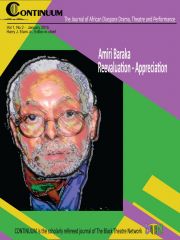Return to The Toilet
Melinda Wilson Ramey
Abstract
Set in a high school lavatory in the early 1960s, the first production of LeRoi Jones’s The Toilet explored Black life, love, and social order. The pivotal one-act play received unfavorable reviews when it premiered off-Broadway in 1964 on a double bill with The Slave. Critics questioned the play’s content, conclusion and casting that rendered mixed signals regarding the state of American race relations. Jones used the culture of Black male youth as a backdrop for addressing issues of race and homosexuality particular to the 1960s. The Toilet presented Ray Foots, the main character, coming of age while struggling to come to terms with being both Black and homosexual. As a piece of Revolutionary theatre, the play also suggested that before Blacks and whites could come together, they would inevitably come to blows first. Critics did not know, however, that Jones intentionally shaped the play’s conclusion to promote racial reconciliation, and the production’s use of nontraditional casting only caused further confusion.
Return to The Toilet
The Toilet is about the lives of black people. White people tell me it is not […] They try to deny my version (and any black man’s version) of American reality, on the stage, just as they do on the street. They insist that there is no reality except the poisonous numbness they are struck with (which they insist, yes they do, is beautiful).
The Toilet is also a play about love. And a boy’s inability (because he is the victim) to explain that he is something stranger than the rest, even though the blood and soul of him is theirs. It is a play about social order, and what it can mean, i.e.: the brutality its insistence will demand, if it is not an order which can admit of any man’s beauty.
− LeRoi Jones, The Best Plays of 1964-1965, 244
When LeRoi Jones’s one-act play, The Toilet, premiered off-Broadway at the St. Marks Playhouse in December 1964, its locale, excessive language, and violence appalled critics.1 The play showed a group of Black teenagers beating Jimmy Karolis, a white homosexual youth, then leaving him alone on the bathroom floor. George Oppenheimer (1964) of Newsday characterized the black youth as “a bestial collection of […] savages.” Michael Unger (1964) of The Newark Evening News and Martin Gottfried (1964) of Women’s Wear Daily bashed Jones for being “an angry young Negro author” whose “obsession with a single – and hopelessly childish – hatred will prove ruinous to his art,” respectively. James Davis (1964) of the New York Daily News was so shocked that he left the theatre at intermission without seeing its companion piece, The Slave.2 The Toilet perplexed many who saw its original production; they interpreted it as either a beautiful myth or meaningless harangue. I contend, however, that as a piece of Revolutionary Theatre, The Toilet served as metaphor for the current state of American race relations, sensationalized representations of Black masculinity to illuminate homophobic insecurities that couched issues of homosexuality in inter-racialist terms, and questioned racial reconciliation to show the intricate interplay of race, sex, and gender in the early 1960s.
Read the rest of this article in PDF version. View PDF ![]()



